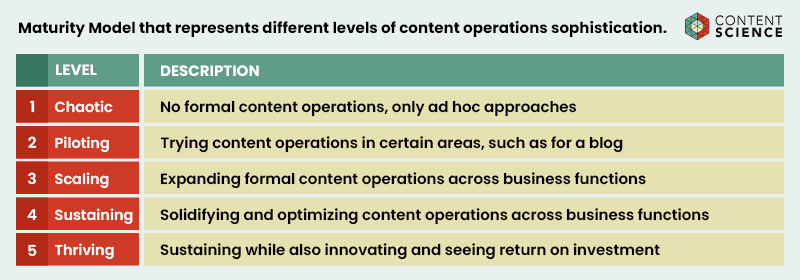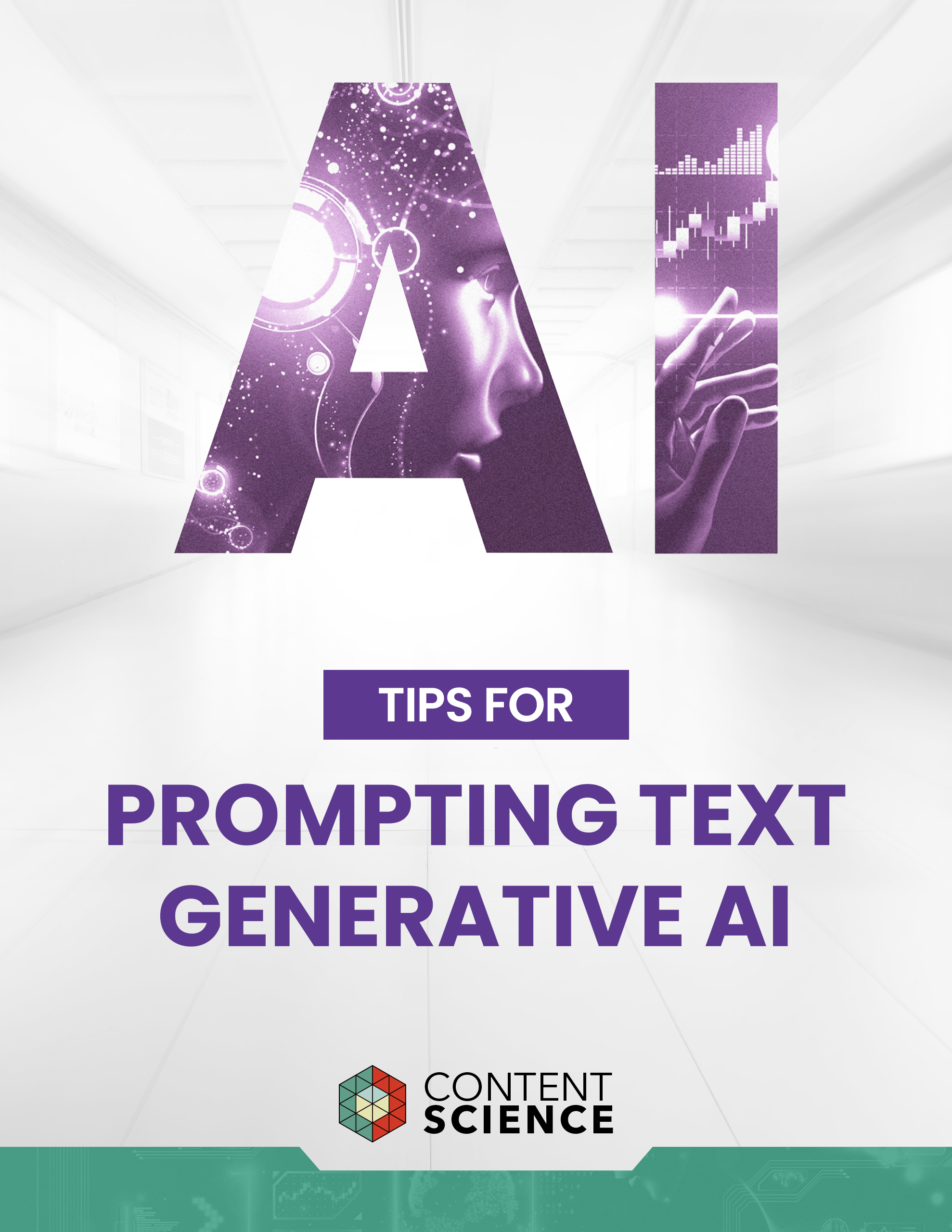
The iconic poet Maya Angelou once said
If you don’t like something, change it. If you can’t change it, change your attitude.
When it comes to modern content strategy, it’s time to change our attitude and our application. I believe the core definitions floated over the years, like them or not, largely still apply. But discussion of the implications needs an upgrade for operating in today’s digital world,
In this article, I walk through why organizations need content strategy today more than ever, a limitation of past concepts of content strategy, and a few characteristics of modern content strategy. My purpose is to help equip current and aspiring content-curious leaders to articulate content strategy work for current organizational challenges and opportunities.
3 Reasons to Focus on Content Strategy Now
In some circles, discussion of content strategy has waned and discussion of content design has increased. In other circles, discussion of content marketing has not necessarily increased, but remained steady. Unfortunately, I think some have interpreted these trends as content strategy is on the way out.
I interpret the situation quite differently. Content design is one of the first specialist roles / functions emerging to carry out content strategy, and I’m excited to see its growth. I also look forward to the same happening with other specialist roles / functions. And in content marketing circles, strategy has always been part of the conversation. It’s an example of applying content strategy within a business function. Every business function will need discussion of content strategy.
At the same time, content strategy has grown in importance, whether or not it’s a hot topic of conversation. Here’s why.
1. Polarizing Trends Threaten Reputations, Force Competition, + More
In considering the State of Content now, the Content Science team and I noted a number of trends with an impact on content. I’m calling out two implications for content strategy.
Reputation + Trust
Today, an organization’s reputation faces a range of threats such as
- Any company, organization, or brand could be pulled into disinformation or misinformation. An extreme example is the alleged rigging of Dominion Voting Systems as part of election fraud dis/misinformation.
- Hacking attacks can lead not only to customer information hitting the dark web but also company information or internal communications shared out of context. Organizations ranging from Sony to Volkswagen to school districts have experienced a mix of these attacks.
- Governments in the U.S. and Europe have intensified efforts to hold organizations accountable for fraud, dark patterns, causewashing, privacy violations, and more, and those efforts receive big media coverage. These accountability efforts are not limited to the technology industry. For instance, the U.S. Consumer Financial Protection Bureau is making headway in a lawsuit against TransUnion for dark patterns that misled consumers into signing up for subscriptions.
Additionally, privacy regulations mean organizations cannot rely on third party data about their customers and must find a way to build first-party data, or data collected directly from customers or users (some also refer to this as zero-party data). Most people do not voluntarily give information to organizations they do not trust.
Competition + Technology
A strong antitrust sentiment has emerged toward big tech in the U.S. and Europe. Some of these lawsuits have already succeeded, and it seems likely that more will. Many of these companies are changing policies and features to introduce more competition and might be forced to break up.
At the same time, our technology boom is introducing more competition in many areas, including content technology. Companies have more options for their content technology stack than ever before, many of which feature advanced artificial intelligence.
The technology boom also might drive digital disruption in your industry and have a big impact on your company. Let’s turn to that trend.
2. Digital Disruption Drives Cloud / SaaS Models
I’ve said it before. I’ll say it again because it’s still happening and won’t stop anytime soon. As every business goes digital, content becomes critical. Content is part of every business function and every phase of customer, audience, and employee journeys.
Many organizations are having to either embrace digital transformation for the first time or embark on yet another cycle of it. In many cases, this means adapting business models or products to be more like a SaaS or cloud offering. This trend affects every sector and every context, B2B and B2C alike. Steven Pritt, VP of Content Marketing COE of Thomson Reuters notes some of the consequences for content.
There is no doubt that content plays a crucial role in marketing, but lines are getting grayer where marketing begins and ends. In 2023 smart marketing teams will partner with teams responsible for the customer experience (CX) and brand experience (BX) to get a fuller view of how customers see their business.
The implications of becoming “as a service” for a business and its content cannot be overstated. I like the way this McKinsey article explains the level of change required.
3. Recession or Uncertainty Means Doing More with Less
Talk of a recession and general uncertainty about the future leaves many organizations forced to do more with less. If the value or any effort or team either isn’t clear or isn’t tied to a priority, it’s likely to change or stop. Content is no exception. Jonelle Wilkinson-Seitz, Colby Phillips, and Meredith Deaver of AT&T articulate the situation like this:
In challenging economic times, we see a growing focus on demonstrating the value of content in de-risking projects and driving ROI. With a new position in our organization and growing access to business analytics, we plan to build enterprise-level processes that drive cohesion and emphasize consistency. All while ensuring our content remains inclusive, in language and practice.
To address the three trends above, ironically organizations need to invest more in content strategy, not less. Content strategy is foundational to
- Aligning content efforts with organizational priorities and performance.
- Defining a clear organization or brand purpose and bringing it to life in useful and entertaining ways.
- Creating differentiated products and end-to-end experiences that don’t have to rely on dark patterns or causewashing to succeed.
- Providing paths to trustworthy communication about mistakes or missteps.
- Ensuring communications and information are consistently accurate and inclusive.
- Contributing to a playbook for responding to a crisis.
- Driving the right rules, standards, triggers, and governance for advanced content technology.
- Figuring out how to gain first party data through useful and engagigng content experiences.
- Selecting content opportunities and projects that are likely to succeed or have a meaningful impact.
- Making content operations efficient and scalable.
So, content strategy is crucial to surviving or thriving in today’s digital world. But, we need the right attitude and application.
3 Limitations of Lingering Content Strategy Concepts
To modernize our view and use of content strategy, we can start by letting go of some outdated concepts.
1. Enterprise: The Right Connotations?
I view the intent of “enterprise content strategy” as similar to the intent of the term “enterprise software.” It was a way to convey addressing the needs of complex, large companies. Today, attaching “enterprise” to a term like “software” brings up a host of negative connotations: Slow, burdensome, overly complex, serving the organization at the expense of the individual end user or developer / administrator. But, over the past 10 years, the distinction between enterprise software and consumer software has become “increasingly irrelevant,” as Jon Kolko notes in this Harvard Business Review article. Today, businesses of every size use Salesforce products, Atlassian products, and Google products, to name only a few examples. In a similar vein, I believe “enterprise content strategy” is no longer relevant because every growing organization or business has complexity that benefits from strategy, not simply an enterprise.
So, I see attaching “enterprise” to “content strategy” as
- At best, unnecessary because every growing business or organization has complexity.
- At worst, tapping into the same negative connotations as “enterprise software.”
2. Unified: One Size Fits All?
Another term often used with content strategy is “unified.” One intent behind this term was to address silo syndrome, where one part of an organization is unaware of what another part is doing with content, leading to problems like duplicate effort, redundant tool purchases, gaps in effort, conflicting strategies, and the like. But the term “unified” means bring together as one. I’ve seen that be interpreted time and again as one content strategy for all organizational needs.
I also have heard and seen quips recently along the lines of “Enterprise unified content strategy is like a unicorn. It doesn’t exist.” I’m not sure this concept was ever tenable, but it certainly isn’t now. However, silo syndrome and complexity are still challenges modern content strategy needs to address.
3. Static: Set It + Forget It?
One reason to invest in content strategy is content strategy can bring tremendous repeatable value. You make the effort to form the strategy once, and you get value from it in many ways over time. But, this benefit has been interpreted as the content strategy doesn’t change, or doesn’t need to change for a very long time. I continue to see content strategy provide lasting value, but content strategy does have to evolve as trends, organizational priorities, and market contexts change.
If we let go of these concepts, then what now characterizes content strategy? Let’s turn to that question now.
4 Characteristics of Modern Content Strategy
Let’s begin with more wisdom from Angelou:
I can be changed by what happens to me. But I refuse to be reduced by it.
Our changing times mean content strategy has to change. And I don’t see that as a reduction. I see it as an expansion and a sophistication. Let’s explore four characteristics of modern content strategy.
1. Led by Unique Vision
In my experience and Content Science’s research, we have identified content vision as a top success factor. A content vision articulates the purpose and future state you aspire to for content.
If your organization’s content strategy (or set of strategies) lacks a vision, then it is not strategy; it’s a collection of best practices. By including purpose and being unique, content vision helps ensure content strategy addresses threats like reputation damage and intensified competition.
Additionally, content vision makes adapting to change easier, not harder. Your content vision might remain the same, but unexpected changes in your current state mean your content strategy and operations have to evolve. For example, Lymari Morales of Johns Hopkins University co-created a vision with her team. And here’s what happened next.
We did that [create a vision] in late 2019 to start piloting it in January 2020…and then when the pandemic came, we were already playing from the same playbook to apply those ideas to this information moment.
Morales and team defined a content vision before the pandemic started, yet they found it invaluable as they navigated changing their approach during the pandemic. I see content vision as the missing link between some of the intention behind “unified content strategy” and the alignment through change that organizations inevitably face today.
Additionally, a vision provides a way to align and integrate more than one content strategy, which brings us to the next characteristic of modern content strategy.
2. Integrated Across End-to-End Experiences
To serve truly end-to-end experiences, every organization that is serious about digital transformation needs not one content strategy but a set of content strategies. The exact combination of content strategies needed might vary from company to company, but not the need for more than one. These content strategies should support each other, not undermine each other.
As a simple example, you might need an overarching vision and content strategy to support the journey of a key segment of customers. And, you might need
- A content strategy to address the phases related to marketing.
- A content strategy to address sales enablement.
- A content strategy, or set of them, for specific marketing campaigns.
- A content strategy for specific websites or channels.
- A content strategy to improve experiences like using the product or service.
- A content strategy to address customer success and support.
Separately a company likely needs
- A content strategy, or set of them, for public relations and communications.
- A content strategy, or set of them, for end-to-end employee experiences, from internal communications to role-based enablement.
- A content strategy, or set of them, for partner communications and enablement.
You get the idea. So, I view integrated content strategies, to some extent, as nesting dolls. They are related, but they are not exactly the same.

The concept of integration addresses the intent of concepts like enterprise and unified in a manner more appropriate for today’s inevitably complex digital world.
3. Updated Regularly with Intelligence
A content strategy is a plan to move from the current content state to the desired future state–the content vision. Your content strategy likely will need to evolve as
- The current state changes, such as the pandemic hits or business priorities change.
- You learn lessons from making progress toward the vision, such as you learn more about content effectiveness and customer needs, preferences, interests, and expectations.
Instead of assuming a content strategy is static, a modern view is content strategy will evolve. Deciding when to change the content strategy and how requires reliable content intelligence. It’s like being a geologist who knows earthquakes will happen but needs data from a system of sensors to identify when they’re happening and how severe they are to figure out a response.
The good news is establishing a system of content intelligence is much easier than setting up an earthquake detection system—especially with the right consideration of content operations.
And that leads us to the fourth and last characteristic of modern content strategy.
4. Driving Maturity and Resiliency of Operations
Today, a content strategy without supporting content operations is just a nice idea. The two should be inextricably linked. (This strong link is one reason why I don’t view content capabilities as part of design.) So, as a company applies modern content strategy with characteristics one through three above, chances are the company’s content operations will need to mature. And, in our tumultuous times, those content operations will need to be resilient.
Content Science has studied success factors in content operations for several years now. Based on that research, we developed a maturity model to support productive conversations about progress in content operations.

I don’t claim this model is perfect, but it is useful. Modern content strategy involves more conversation about issues such as whether a new content strategy really is sustainable and how a change to a content strategy will drive changes to process or technology or roles. To start your own conversation, do a quick gut check of your own organization’s content operations with this interactive assessment.
Conclusion
I’m excited about the renewed importance content strategy can have in every company and organization today. But the content strategy concepts that got us here are not the same ones that will serve us now and in the future. It’s time for modern content strategy that is led by vision, integrated across experiences and functions, updated regularly, and driving resilient content operations.
Events, Resources, + More
Workshop: Are You Ready for AI?
Is your organization really ready for AI at scale? Let the Content Science team guide your leaders through assessing 4 areas of readiness.
Course: Prompting Text Generative AI
Learn how to bring out the full potential of text generative AI to create impactful content from this on-demand course.
Webinar: Benchmarks for Content Effectiveness
It's not about more content. It's about more effective content. Gain tips based on Content Science's unique research + experience.
The Ultimate Guide to End-to-End Content
Discover why + how an end-to-end approach is critical in the age of AI with this comprehensive white paper.






Comments
We invite you to share your perspective in a constructive way. To comment, please sign in or register. Our moderating team will review all comments and may edit them for clarity. Our team also may delete comments that are off-topic or disrespectful. All postings become the property of
Content Science Review.